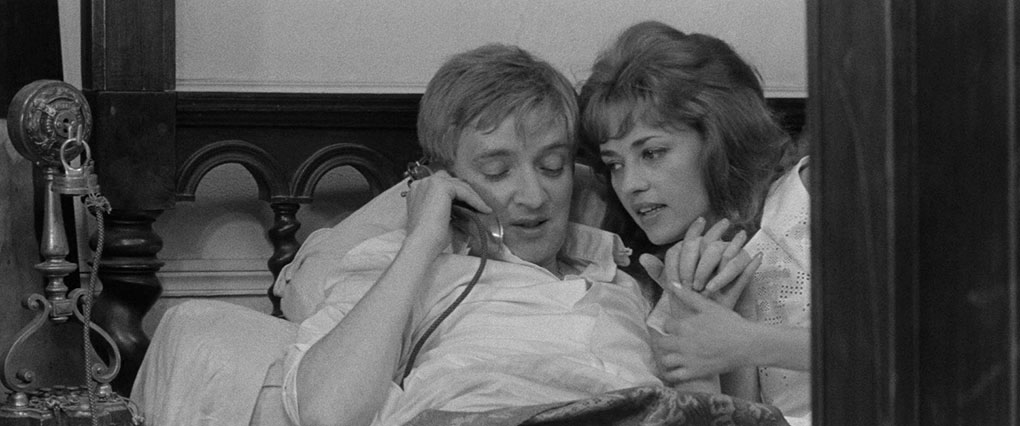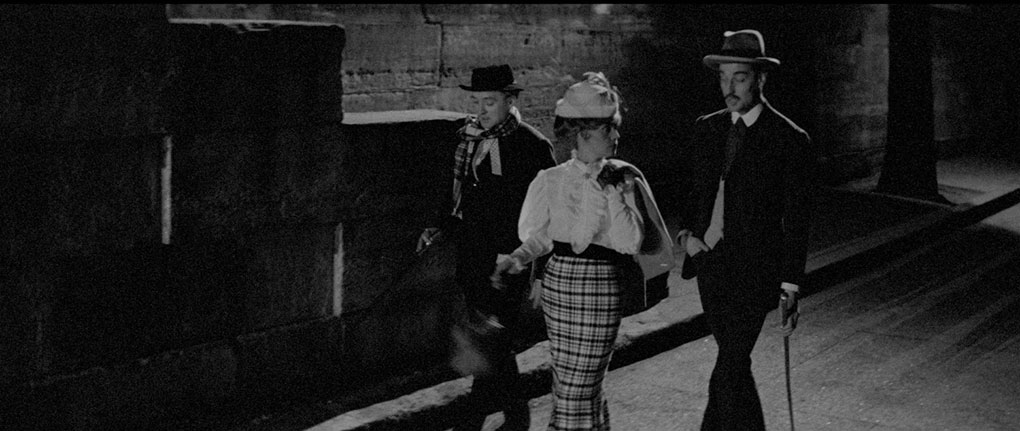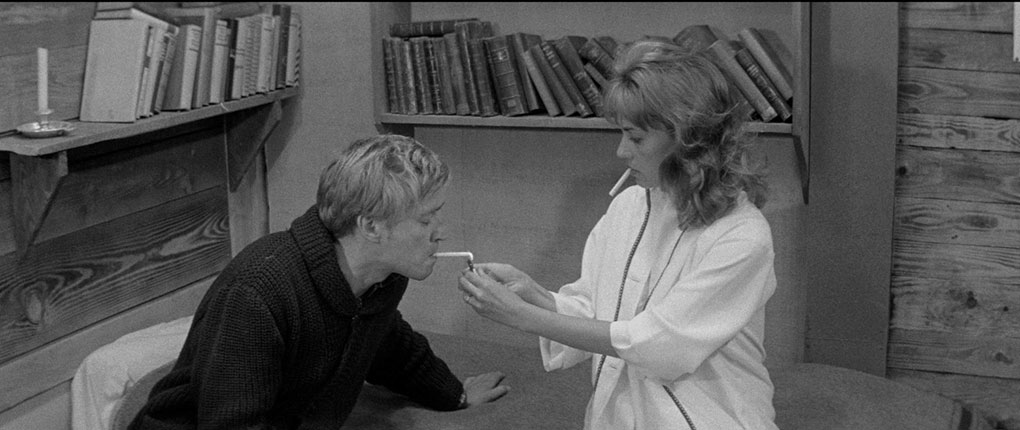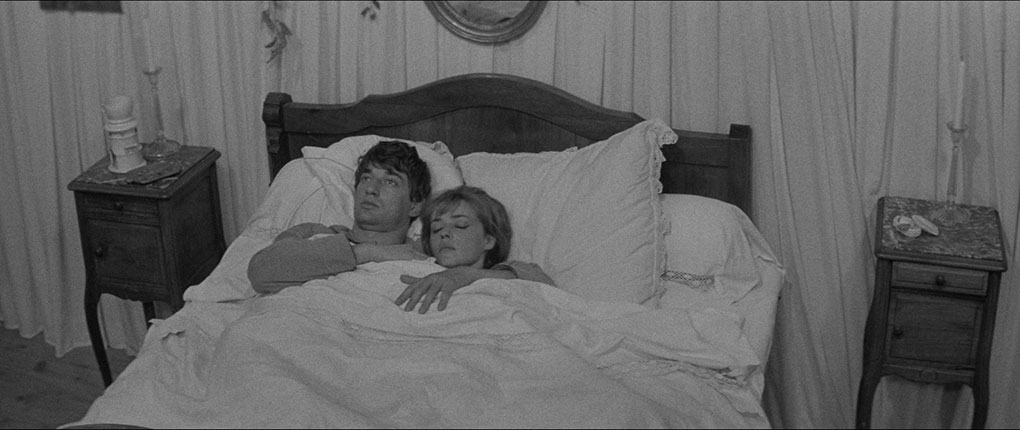|
France, before the First World War. Austrian Jules (Oskar Werner) meets French Jim (Henri Serre) and they soon become the best of friends. Then they meet Catherine (Jeanne Moreau), who will have a major effect on both of their lives.
Jules et Jim was François Truffaut's third feature and at least in hindsight it's the culmination of Truffaut's early work, that of after all a young man who turned thirty in its year of release. It was a success and rapidly picked up a cult following. While The 400 Blows had been a story of childhood, and Shoot the Pianist (Tirez sur le pianiste, 1960) was heavily indebted to Hollywood, especially film noir, Jules et Jim is a love story, one between adults, and it goes back into the past. It draws on classical film conventions while making them fresh with its New Wave exuberance. And some Gallic naughtiness by the standards of the time certainly didn't hurt, given that the film centres on a love triangle, not a polyamorous one as we'd think of it nowadays, but a serially monogamous one. Even so, that wasn't what you generally saw in American or British films at the time. 1962 is a little early for what we have come to think of as the Sixties, but a certain je ne sais quoi was certainly in the air.

The film is based on a novel by Henri-Pierre Roché, published in 1953. The author was then in his seventies, having been an art dealer and collector and having known a large number of the major writers and artists of the first half of the twentieth century. His novel told a story based on his own experiences fifty years earlier. Truffaut found a second-hand copy of the novel and determined to film it. He contacted the now-elderly Roché and kept him informed of the progress of the film adaptation. Four days before his death, Roché wrote to Truffaut, approving of the casting of Jeanne Moreau as Catherine. Truffaut and Jean Gruault wrote the screenplay, as faithful as possible to the novel: the narration by Michel Subor is often word for word. It was a lasting regret for Truffaut that Roché never got to see the film. A decade later, Truffaut adapted Roché's only other novel, Les deux anglaises et le continent (Anne and Muriel in the UK, Two English Girls in the USA).
While Jules et Jim is undoubtedly a love story, it's a story of the platonic love between the two men of the title, from beginning to bittersweet end. While Jeanne Moreau has top billing and is indelible as free-spirited woman who becomes involved with both men, the film isn't ultimately about her. It's more about the impact she has. The other women in the story – Gilberte (Vanna Urbino) and Thérèse (Marie Dubois) – move in and out of the story but we concentrate on the central three. There is also a young child in the shape of Sabine (Sabine Haudepin, who acted again for Truffaut as a child in his next film, La peau douce, and as an adult in The Last Metro). without too much of the sentimentality that Truffaut was later prone to when dealing with children.
Jules et Jim wears its historical setting lightly, with little dropping of significant dates and events. We travel from the Great War in which Jules and Jim fought on different sides (and Jim was scared of having to kill Jules in conflict) to a Europe on the brink of another war. As with his earlier two features, there's a stylistic joie de vivre to Jules et Jim: a mobile camera, freeze-frames, Truffaut narrowing the Scope frame and widening it out again, cutting in archive footage. Raoul Coutard's black and white cinematography is exemplary. Coutard was a key cinematographer of the New Wave, having shot A bout de souffle and continuing to work regularly for Godard. He had first worked with Truffaut on Shoot the Pianist and shot all of the director's films – except for the British-made Fahrenheit 451, which Nicolas Roeg shot, Truffaut's first film in colour and in English – until The Bride Wore Black (La mariée était en noir, 1968) when they had a falling-out. Time magazine listed George Delerue's score as one of the ten best of all time.

Jules et Jim escaped Oscar attention, but the BAFTAs nominated it for Best Film from Any Source and Jeanne Moreau as Best Foreign Actress. It lost to Lawrence of Arabia and Anne Bancroft for The Miracle Worker respectively. The film has been very influential on later films, including, you might be surprised to hear, Goodfellas, Scorsese taking inspiration from Truffaut's use of narration.
If Jules et Jim was a culmination of Truffaut's career to date, it was also a turning point. Next was the short Antoine et Colette (part of the portmanteau feature Love at Twenty, also 1962), in which Jean-Pierre Léaud returned as the now seventeen-year-old Antoine Doinel. His next feature was La peau douce, in which Truffaut returned to contemporary times, and a more classical form of filmmaking, less a young man's film but a more adult one. Jules et Jim is many people's favourite amongst Truffaut's films, and it's a delight.
Released simultaneously with The 400 Blows, Jules et Jim is one of four Truffaut films to be released on Blu-ray by the BFI, with La peau douce and The Last Metro to follow. The disc is encoded for Region B only. The film has had several previous disc releases, and some of the extras have been carried over from then. Jules et Jim had an X certificate (then, restricted to those aged sixteen and over) in cinemas on its original release. More recently, it was a PG but more recently still has been uprated to a 12.
Jules et Jim was shot in black and white 35mm with anamorphic lenses (Franscope). Along with Antoine et Colette the same year, visually the film marks a turning point in Truffaut's work. From his next feature, with the sole exception of Mississippi Mermaid (La sirène du Mississipi [sic], 1969), Truffaut and his cinematographers would favour narrower aspect ratios, most often 1.66:1. The Blu-ray transfer, derived from a 2K restoration of the original camera negative, is in the correct ratio of 2.35:1. Coutard's cinematography is more "black and white" and less greyscale than Henri Decaë's on The 400 Blows and that comes across very well in this transfer. The archive footage is easy to spot: much grainer and in some cases slightly stretched into Scope, but that's the way it's always been with this film.

The soundtrack is the original mono, rendered as LPCM 2.0. It's clear and well balanced, with Delerue's score coming through very well. As with The 400 Blows, the film was almost entirely post-synchronised (the exception being the scene where Catherine sings the song "Le tourbillon") but if the lipsynch does wander in places, I didn't notice. The film is almost all in French, with some lines spoken in German by Werner and one line in English by Moreau. In a couple of places there are burned-in French subtitles translating German dialogue on screen but they've been there every time I've seen the film. Optional English subtitles are available for the film, the Moreau commentary and the Truffaut interview, or if your French is good enough, you can switch them off.
Commentary with Jeanne Moreau
Recorded in 2000, this is actually an interview with Jeanne Moreau conducted by critic Serge Toubiana, in French with optional English subtitles. There are some gaps as Moreau seems to take a while to warm up to the conversation, but it covers a lot of ground, including her meeting with Truffaut (who made her read the novel) and such episodes where she jumped into the Seine for real and was ill for a couple of days afterwards as a result.
François Truffaut Panel Discussion (53:52)
This discussion took place at the BFI Southbank on 29 January 2022, as part of a study day, François Truffaut's Cinematic and Literary Influences. Coordinated by Ginette Vincendeau, it begins with prerecorded answers to her questions by Pasquale Iannone, Marilyn Mallia and Sonali Joshi, and then Vincendeau continues the discussion with Catherine Wheatley. The questions relate to which film was Truffaut's masterpiece (The 400 Blows comes up a few times but Wheatley doesn't think that Truffaut actually made a masterpiece). Vincendeau and Wheatley take questions from the audience, which includes the intriguing one that Truffaut may be a New Wave filmmaker who appeals more to women than others of his colleagues. That's not necessarily to do with Truffaut being more "emotional" and Godard, say, being more cerebral, which is a reductive stereotype about men and women anyway. Wheatley does note that most Truffaut scholars are women, which isn't the case with Godard or Rohmer scholars, for example.

John Player Lecture: François Truffaut (53:10)
Not for the first time, information seems to be lacking regarding the lectures (rather, as in this case, interviews) which John Player cigarettes sponsored at the National Film Theatre in the early 1970s. This one is listed as "c. 1972" in the booklet, though it would appear that that year is correct. (During the interview, Truffaut's then newest film, Anne and Muriel, is mentioned as due to open at the Curzon Cinema in Mayfair, taking over from The Last Picture Show, and Anne and Muriel was released in London in August of that year.) The interviewer is not identified either: if he can be identified, this review can be updated. He begins in English by stating that due to Truffaut's inability in English, the interview would be conducted in French, with earphone translation available to the audience – and for this recording, optional subtitles as the audio plays over the film. Truffaut is on good form, talking in particular about The 400 Blows, as this interview followed a screening of that film. This audio recording plays over the feature, with the feature audio taking over after the interview finishes.
Jeanne Moreau in Conversation (82:52)
The booklet is more specific here: Moreau is interviewed by Don Allen, again at the National Film Theatre, on 5 April 1982. Moreau speaks in English. This is a reminder of how things were, in the days before digital projection: Allen mentions that they had hoped to show an extract from Louis Malle's Les amants, but the print available wasn't in good enough condition. A discussion of screen nudity comes over a little uneasily forty years later, but we also find out that Moreau, who had an English mother and was living in England at the time, was in the Brownies. She didn't make the Girl Guides, though, as the World War II had broken out and she had to return to France. She talks about how she met Truffaut when he was a critic and more than a little shy: they had several meals together (he snails and spinach, she salad and steak) barely exchanging a word – and then he phoned her asking her to make her brief appearance in The 400 Blows. Moreau is occasionally flirtatious and occasionally spiky, declining to be called a feminist and disliking labels, and maintaining that great male directors have a feminine side (her example is Ingmar Bergman) but great women have a masculine side. Film extracts shown during the conversation (including one from Moreau's second film as director, L'adolescente, 1979, which, Allen points out, never had UK distribution). Questions from the audience are not always audible. As with the Truffaut interview, this plays as an alternative audio track over the main feature.
Screen Epiphanies: John Hurt on Jules et Jim (8:29)
Interviewed at the BFI Southbank on 23 January 2010, John Hurt tells how he first saw Jules et Jim. At RADA in London at the time, he followed a friend's suggestion to see the film, then showing at the Cameo-Poly in Regent Street (now the Regent Street Cinema) and was so taken by it that he saw it six more times on consecutive Sundays. Part of this was to become so familiar with a fairly dialogue-heavy film that he would no longer need to rely on the subtitles. Hurt's interviewer is unidentified in this item, nor is he identified in the booklet.

Theatrical trailer (3:18)
Another lengthy effort, possibly due to uncertainly as to how to pitch this to a general audience rather than the cinephiles who would go to see the new film by the director of The 400 Blows, but that film is namechecked too.
2022 reissue trailer
Again, now that this is no longer a new film but an established classic, a rather shorter trailer. If the BFI's logos and text on their 400 Blows reissue trailer were in yellow, this time they're in pink.
Stills gallery (6:46)
A self-navigating gallery of production stills, including one British front-of-house card from the film's original cinema release.
Booklet
The BFI's booklet runs to twenty-eight pages and is available with the first pressing only. It begins with "Luminous Memory", an essay by Pasquale Iannone, which begins by discussing a 1995 interview with Jeanne Moreau and her recollections of working with many of the major European directors of the late 1950s and early 1960s. She had more chemistry with Truffaut than she had with, say, Michelangelo Antonioni, with whom she made La notte right before Jules et Jim. Iannone gives us some detail of Roché's original novel, which, being short and elliptical in approach, seemed ready-made for cinematic adaptation. Truffaut found making the film a happy experience, and Moreau was a large part of the reason for that.
Lillian Crawford continues with "Three is a Magic Number: Ménage à trois as the Resolution to the Nouvelle Vague's Relationship Problem", which compares the central relationships in Truffaut's and Godard's films, which potentially could become a threesome but don't quite, with later films which directly reference them, by Bernardo Bertolucci and Wes Anderson for example, where there's no such reluctance. Also, there's a reticence in Truffaut and Godard (both heterosexual men) about possible homoeroticism between their male leads. Instead, the women, such as Catherine, are expected to move between the two men, or, as in Anne and Muriel, the man moves from one to the other and to other women. Different rules apply to the men and the women in these films, even if you bear in mind their historical settings.
The booklet continues with the (unsigned) review of Jules et Jim from the July 1962 issue of the Monthly Film Bulletin, a six-page biography of Truffaut by Kieron McCormack which is also in the 400 Blows booklet, film credits, notes on the extras, and plenty of stills.
Jules et Jim is many people's favourite Truffaut film and it remains one of his best, retaining its classic status sixty years after it was made. It's well presented on this BFI Blu-ray.
|